An Experimental Validation of Numerical Model for Top-Hat Tubular Structure Subjected to Axial Crush
Abstract
:Featured Application
Abstract
1. Introduction
2. Materials and Experiment Setups
3. Finite Element Model
4. Results and Discussion
5. Conclusions
- Increases in impact speed led to increases in energy absorption and the energy absorption increases linearly with the impact speed
- The predicted force-displacement and energy-displacement results for different speeds have shown good agreement with the experimental results. Therefore, it can be concluded that the numerical model was able to predict the failure and behavior of the closed top-hat.
- The average peak loads of the dynamic test 2 kJ, 3 kJ and 6 kJ were 107, 108 and 112 kN, respectively, with a reduction of 35% to 45% compared with the quasi-static test. In addition, the average energy absorption of the dynamic test with 2, 3 and 6 kJ were 2050, 3180 and 6500 J, respectively, with a reduction from 28% to 77% compared with the quasi-static test.
Supplementary Materials
Author Contributions
Funding
Institutional Review Board Statement
Informed Consent Statement
Data Availability Statement
Acknowledgments
Conflicts of Interest
References
- Mudassir, M.; Tarlochan, F.; Mansour, M.A. Nature-Inspired Cellular Structure Design for Electric Vehicle Battery Compartment: Application to Crashworthiness. Appl. Sci. 2020, 10, 4532. [Google Scholar] [CrossRef]
- Tarlochan, F.; Hamouda, A.M.S.; Mahdi, E.; Sahari, B.B. Composite sandwich structures for crashworthiness applications. Proc. Inst. Mech. Eng. Part L J. Mater. Des. Appl. 2007, 221, 121–130. [Google Scholar] [CrossRef]
- Shen, J.; Flores, M.; Sharits, A. Impact Performance of a Plate Structure with Coconut-Inspired Microchannels. Appl. Sci. 2020, 10, 355. [Google Scholar] [CrossRef] [Green Version]
- Borrelli, A.; D’Errico, G.; Borrelli, C.; Citarella, R. Assessment of Crash Performance of an Automotive Component Made through Additive Manufacturing. Appl. Sci. 2020, 10, 9106. [Google Scholar] [CrossRef]
- Elgalai, A.M.; Mahdi, E.; Hamouda, A.M.S.; Sahari, B.S. Crushing response of composite corrugated tubes to quasi-static axial loading. Compos. Struct. 2004, 66, 665–671. [Google Scholar] [CrossRef]
- Eyvazian, A.; Taghizadeh, S.A.; Hamouda, A.M.; Tarlochan, F.; Moeinifard, M. Buckling and crushing behavior of foam-core hybrid composite sandwich columns under quasi-static edgewise compression. J. Sandw. Struct. Mater. 2020. [Google Scholar] [CrossRef]
- Alkhatib, S.E.; Matar, M.S.; Tarlochan, F.; Laban, O.; Mohamed, A.S.; Alqwasmi, N. Deformation modes and crashworthiness energy absorption of sinusoidally corrugated tubes manufactured by direct metal laser sintering. Eng. Struct. 2019, 201, 109838. [Google Scholar] [CrossRef]
- Mohamed, A.S.; Laban, O.; Tarlochan, F.; Al Khatib, S.E.; Matar, M.S.; Mahdi, E. Experimental analysis of additively manufactured thin-walled heat-treated circular tubes with slits using AlSi10Mg alloy by quasi-static axial crushing test. Thin-Walled Struct. 2019, 138, 404–414. [Google Scholar] [CrossRef]
- Dastjerdi, A.A.; Shahsavari, H.; Eyvazian, A.; Tarlochan, F. Crushing analysis and multi-objective optimization of different length bi-thin walled cylindrical structures under axial impact loading. Eng. Optim. 2019, 51, 1884–1901. [Google Scholar] [CrossRef]
- Eyvazian, A.; Mozafari, H.; Tarlochan, F.; Hamouda, A.M.S. Numerical and experimental investigation on corrugation geometry for metallic tubes under lateral loading. Mater. Sci. Forum 2018, 916, 226–231. [Google Scholar] [CrossRef]
- Alkhatib, S.E.; Tarlochan, F.; Hashem, A.; Sassi, S. Collapse behavior of thin-walled corrugated tapered tubes under oblique impact. Thin-Walled Struct. 2018, 122, 510–528. [Google Scholar] [CrossRef]
- Sami, A.E.; Alkhatib, E.; Tarlochan, F. Collapse behavior of thin-walled corrugated tapered tubes. Eng. Struct. 2017, 150, 674–692. [Google Scholar]
- Tarlochan, F.; Samer, F.; Hamouda, A.M.S.; Ramesh, S.; Khalid, K. Design of thin wall structures for energy absorption applications: Enhancement of crashworthiness due to axial and oblique impact forces. Thin-Walled Struct. 2013, 71, 7–17. [Google Scholar] [CrossRef]
- Tarlochan, F.; Samer, F. Design of thin wall structures for energy absorption applications: Design for crash injuries mitigation using magnesium alloy. Int. J. Res. Eng. Technol. 2013, 2, 24–36. [Google Scholar]
- Tarlochan, F.; Ramesh, S.; Harpreet, S. Advanced composite sandwich structure design for energy absorption applications: Blast protection and crashworthiness. Compos. Part B Eng. 2012, 43, 2198–2208. [Google Scholar] [CrossRef]
- Tarlochan, F.; Ramesh, S. Composite sandwich structures with nested inserts for energy absorption application. Compos. Struct. 2012, 94, 904–916. [Google Scholar] [CrossRef]
- Xu, J.; Ma, Y.; Zhang, Q.J.; Sugahara, T.; Yang, Y.Q.; Hamada, H. Crashworthiness of carbon fibre hybrid composite tubes molded by filament winding. Compos. Struct. 2016, 139, 130–140. [Google Scholar] [CrossRef]
- Wang, Y.F.; Feng, J.S.; Wu, J.H.; Hu, D.Y. Effects of fibre orientation and wall thickness on energy absorption characteristics of carbon-reinforced composite tubes under axial quasi-static and impact crushing condition. Compos Struct 2016, 13, 356–368. [Google Scholar] [CrossRef]
- Hu, D.Y.; Luo, M.; Yang, J.L. Experimental study on crushing characteristics of brittle fibre/epoxy hybrid composite tubes. Int. J. Crashworthiness 2010, 15, 401–412. [Google Scholar] [CrossRef]
- Song, H.W.; Wan, Z.M.; Xie, Z.M.; Du, X.W. Axial impact behaviour and energy absorption efficiency of composite wrapped metal tubes. Int. J. Impact Eng. 2000, 24, 385–401. [Google Scholar] [CrossRef]
- Yan, L.; Chouw, N. Crashworthiness characteristics of flax fibre reinforced epoxy tubes for energy absorption application. Mater. Des. 2013, 51, 629–640. [Google Scholar] [CrossRef]
- Mamalis, A.G.; Robinson, M.; Manolakos, D.E.; Demosthenous, G.A.; Ioannidis, M.B.; Carruthers, J. Crashworthy capability of composite material structures. Compos. Struct. 1997, 37, 109–134. [Google Scholar] [CrossRef]
- Mamalis, A.G.; Manolakos, D.E.; Ioannidis, M.B.; Papapostolou, D.P. On the experimental investigation of crash energy absorption in laminate splaying collapse mode of FRP tubular components. Compos. Struct. 2005, 70, 413–429. [Google Scholar] [CrossRef]
- Mamalis, A.G.; Manolakos, D.E.; Ioannidis, M.B.; Papapostolou, D.P. On the response of thin-walled CFRP composite tubular components subjected to static and dynamic axial compressive loading: Experimental. Compos. Struct. 2005, 69, 407–420. [Google Scholar] [CrossRef]
- Ning, H.; Pillay, S.; Vaidya, U.K. Design and development of thermoplastic composite roof door for mass transit bus. Mater. Des. 2009, 30, 983–991. [Google Scholar] [CrossRef]
- Janowski, G.M.; Vaidya, U.K.; Husman, G. Thermoplastic sandwich structure design and manufacturing for the body panel of mass transit vehicle. Compos. Struct. 2007, 80, 82–91. [Google Scholar]
- Ning, H.; Vaidya, U.K.; Janowski, G.M.; Husman, G. Design, manufacture and analysis of a thermoplastic composite frame structure for mass transit. Compos. Struct. 2007, 80, 105–116. [Google Scholar] [CrossRef]
- Thattaiparthasarthy, K.B.; Pillay, S.; Ning, H.; Vaidya, U.K. Process simulation, design and manufacturing of a long fibre thermoplastic composite for mass transit application. Compos. Part A Appl. Sci. Manuf. 2008, 39, 1512–1521. [Google Scholar] [CrossRef]
- Bartus, S.D.; Vaidya, U.K.; Ulven, C.A. Design and development of a long fibre thermoplastic bus seat. J. Compos. Mater. 2006, 19, 131–154. [Google Scholar] [CrossRef]
- Warrior, N.A.; Turner, T.A.; Robitaille, F.; Rudd, C.D. Effect of resin properties and processing parameters on crash energy absorbing composite structures made by RTM. Compos. Part A 2003, 34, 543–550. [Google Scholar] [CrossRef]
- Muralikannan, R.; Velmurugan, R.; Eswaraprasad, G.L. Energy absorption characteristics of circular composites tubes in quasi static and impact loading. In Proceedings of the IMPLAST 2010 Conference, Providence, RI, USA, 12–14 October 2010. [Google Scholar]
- Ochelski, S.; Gotowicki, P. Experimental assessment of energy absorption capability of carbon-epoxy and glass-epoxy composites. Compos. Struct. 2009, 87, 215–224. [Google Scholar] [CrossRef]
- Hull, D. A unified approach to progressive crushing of fibre-reinforced composite tubes. Compos. Sci. Technol. 1991, 40, 337–421. [Google Scholar] [CrossRef]
- Kostopoulos, V.; Markopoulos, Y.P.; Vlachos, D.E.; Galiotis, C.; Melanitis, N.E. A Heavy-Duty Composite Bridge Made of Glass Polyester Pultruded Box Beams. In Proceedings of the RTO Applied Vehicle Technology Panel (AVT) Specialists’ Meeting on Low Cost Composite Structures, Loen, Norway, 7–11 May 2001. [Google Scholar]
- Bardi, F.C.; Yun, H.D.; Kyriakides, S. On the Axisymmetric Progressive Crushing of Circular Tubes under Axial Compression. Int. J. Solids Struct. 2003, 40, 3137–3155. [Google Scholar] [CrossRef]
- Lou, H.; Yan, Y.; Meng, X.; Jin, C. Progressive Failure Analysis and Energy-Absorbing Experiment of Composite Tubes under Axial Dynamic Impact. Compos. Part B Eng. 2016, 87, 1–11. [Google Scholar] [CrossRef]
- ASTM D30309/D3039M-14: Standard test method for tensile properties of polymer matrix composite.
- Ahmad, Z.; Thambiratnam, D.P.; Tan, A.C.C. Dynamic energy absorption characteristics of foam-filled conical tubes under oblique impact loading. Int. J. Impact Eng. 2010, 37, 475–488. [Google Scholar] [CrossRef]
- Witteman, W.J. Improved Vehicle Crashworthiness Design by Control of the Energy Absorption for Different Collisions Situation. Ph.D. Thesis, Eindhoven University of Technology, Eindhoven, The Netherlands, 1999. [Google Scholar]
- Mamalis, A.G.; Manolakos, D.E.; Ioannidis, M.B.; Papapostolou, D.P. The static and dynamic axial collapse of CFRP square tubes: Finite element modelling. Compos. Struct. 2006, 74, 213–225. [Google Scholar] [CrossRef]
- Farley, G.L. Effect of fiber and matrix maximum strain on the energy absorption of composite materials. J. Compos. Mater. 1986, 20, 322–334. [Google Scholar] [CrossRef]
- Berry, J.; Hull, D. Effect of speed on progressive crushing of epoxy glass cloth tubes. In Institute of Physics Conference Series; Plenum Publishing Corp: New York, NY, USA, 1984; p. 463.e70. [Google Scholar]
- Zingoni, A. Insights and Innovations in Structural Engineering Mechanics and Computation. In Proceedings of the Sixth International Conference on Structural Engineering, Mechanics and Computation, Cape Town, South Africa, 5–7 September 2016. [Google Scholar]
- Gupta, R.B.; Singh, S.K. Detection of Crack and Unbalancing in a Rotor System Using Artificial Neural Network. In Advances in Engineering Design; Prasad, A., Shakti, S., Gupta, R.K., Eds.; Sel. Proc. Flame; Springer: Singapore, 2018. [Google Scholar]
- Liu, P.F.; Zheng, J.Y. Recent developments on damage modeling and finite element analysis for composite laminates: A review. Mater. Des. 2010, 31, 3825–3834. [Google Scholar] [CrossRef]
- Guo, Q.; Yao, W.; Li, W.; Gupta, N. Constitutive models for the structural analysis of composite materials for the finite element analysis: A review of recent practices. Compos. Struct. 2021, 260, 113267. [Google Scholar] [CrossRef]

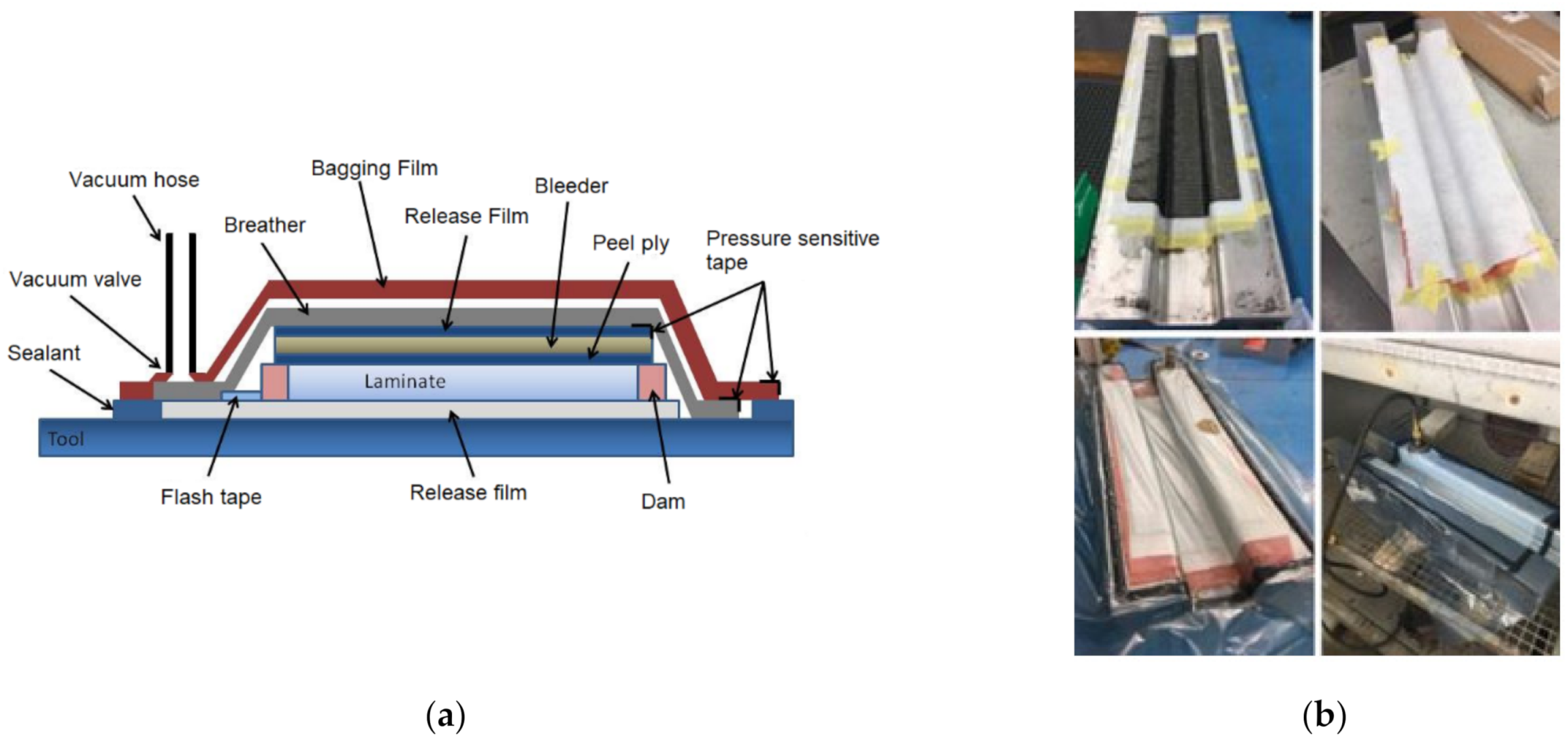

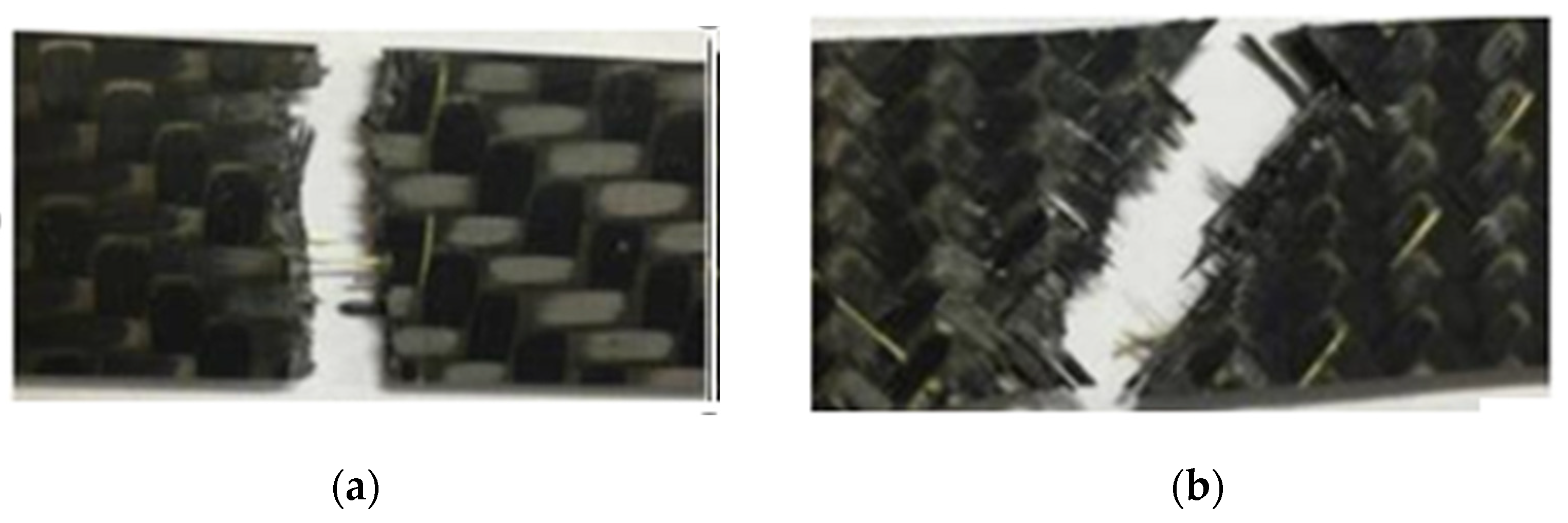
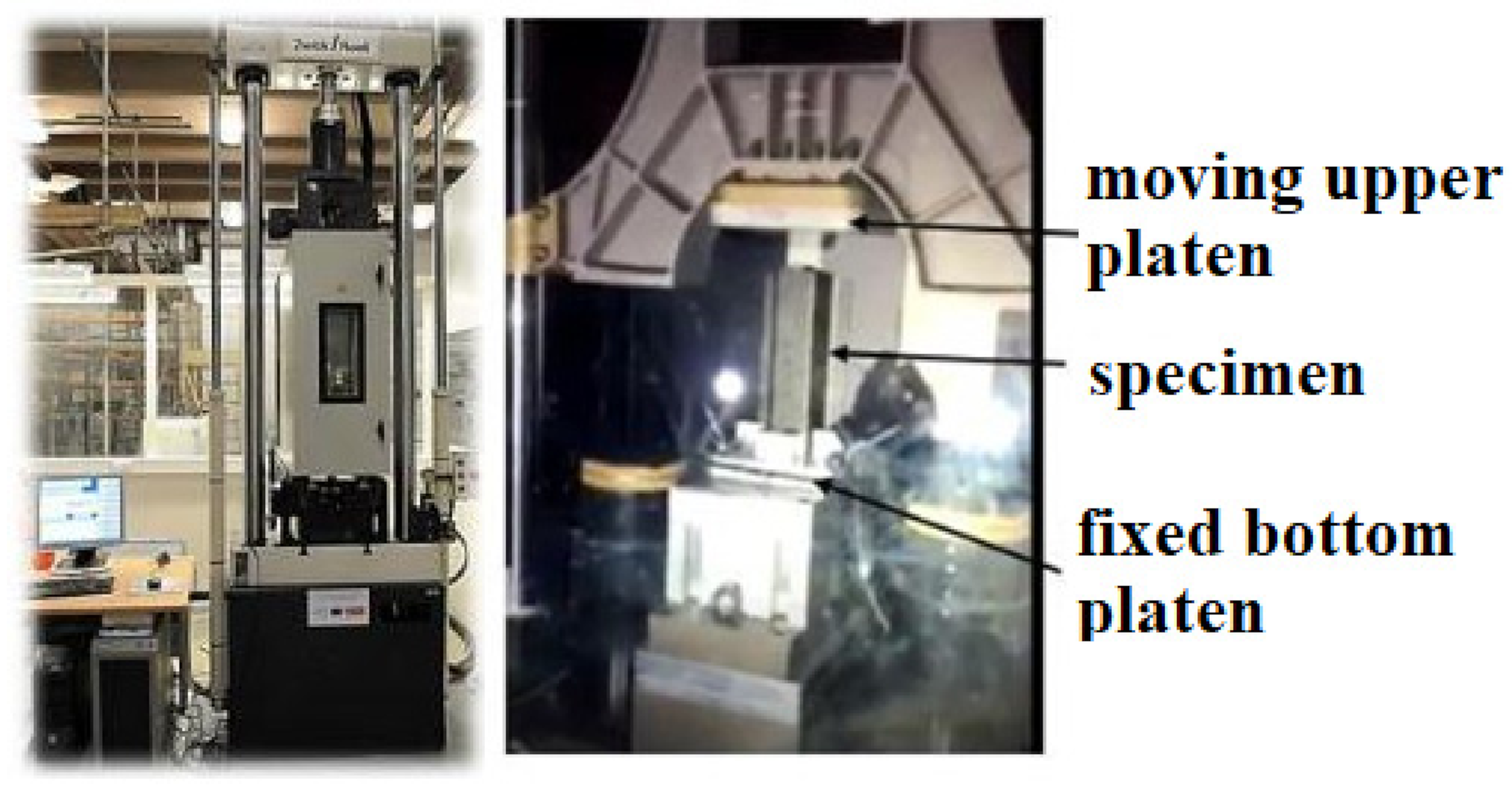

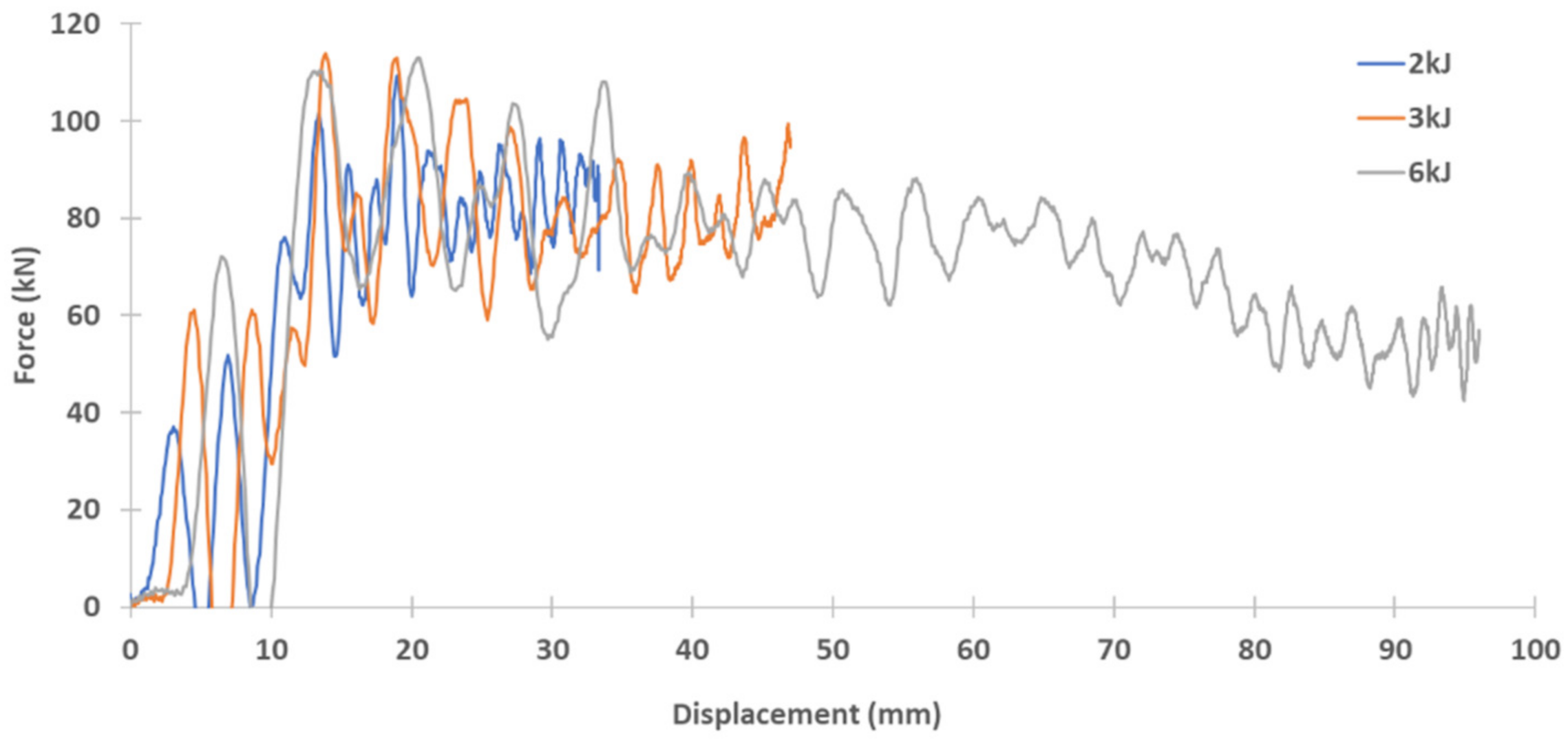




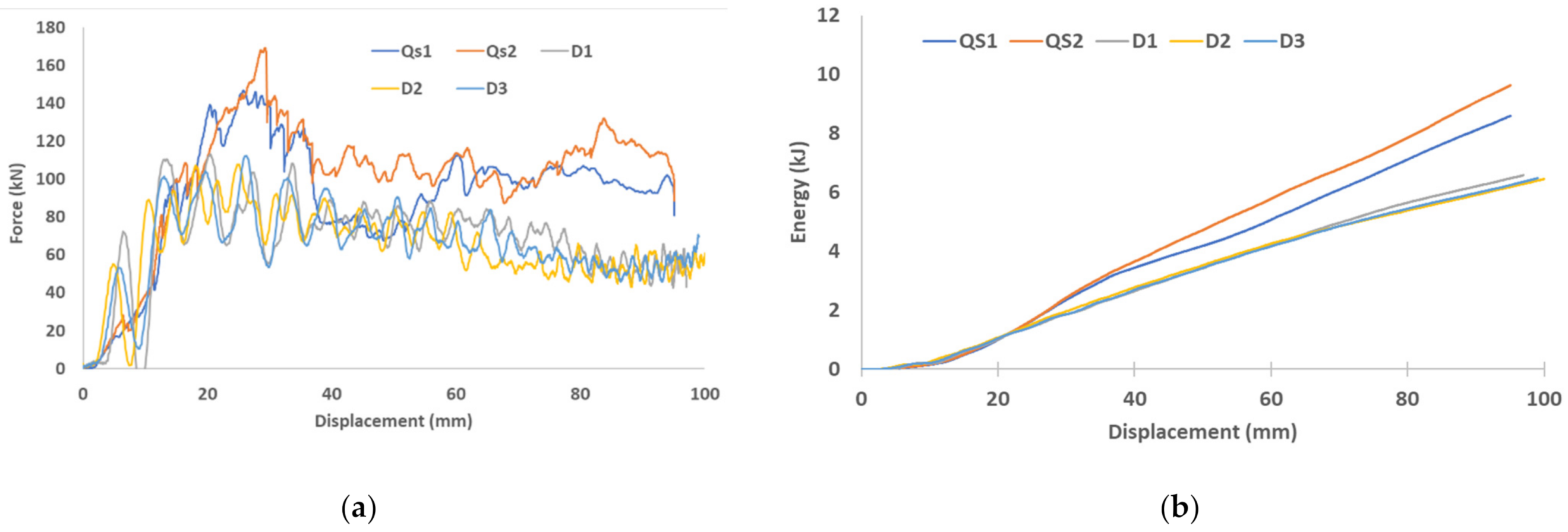
| Material Property | Units | Value |
|---|---|---|
| Young’s modulus, tension in direction | (GPa) | 70 |
| Young’s modulus, compression in direction | (GPa) | 70 |
| Shear modulus in plane 1–2/ | (GPa) | 4 |
| Poisson’s ratio in plane 1–2 | 0.05 | |
| Tensile strength in direction 1/(MPa) XT | Xt (MPa) | 760 |
| Compressive strength in direction 1 | Xc (MPa) | 610 |
| Shear strength in plane 1–2 | (MPa) | 100 |
| Approximate Impact Energy | Parameter | Average Experimental | Numerical | Error % |
|---|---|---|---|---|
| ~2.1 kJ (sample ID: 2 kJ) | Mean load (kN) | 66.9 | 58.2 | 13 |
| Energy (J) | 2047 | 1850 | 10 | |
| Crushing length (mm) | 34 | 33.8 | 1 | |
| ~3.2 kJ (sample ID: 3 kJ) | Mean load (kN) | 66.6 | 62.3 | 6 |
| Energy (J) | 3179 | 2755 | 13 | |
| Crushing length (mm) | 50 | 48.8 | 2 | |
| ~6.6 kJ (sample ID: 6 kJ) | Mean load (kN) | 63 | 65.5 | 4 |
| Energy (J) | 6580 | 5756 | 13 | |
| Crushing length (mm) | 97 | 90 | 7 |
Publisher’s Note: MDPI stays neutral with regard to jurisdictional claims in published maps and institutional affiliations. |
© 2021 by the authors. Licensee MDPI, Basel, Switzerland. This article is an open access article distributed under the terms and conditions of the Creative Commons Attribution (CC BY) license (https://creativecommons.org/licenses/by/4.0/).
Share and Cite
Abdulqadir, S.F.; Tarlochan, F. An Experimental Validation of Numerical Model for Top-Hat Tubular Structure Subjected to Axial Crush. Appl. Sci. 2021, 11, 4792. https://doi.org/10.3390/app11114792
Abdulqadir SF, Tarlochan F. An Experimental Validation of Numerical Model for Top-Hat Tubular Structure Subjected to Axial Crush. Applied Sciences. 2021; 11(11):4792. https://doi.org/10.3390/app11114792
Chicago/Turabian StyleAbdulqadir, Samer Fakhri, and Faris Tarlochan. 2021. "An Experimental Validation of Numerical Model for Top-Hat Tubular Structure Subjected to Axial Crush" Applied Sciences 11, no. 11: 4792. https://doi.org/10.3390/app11114792







